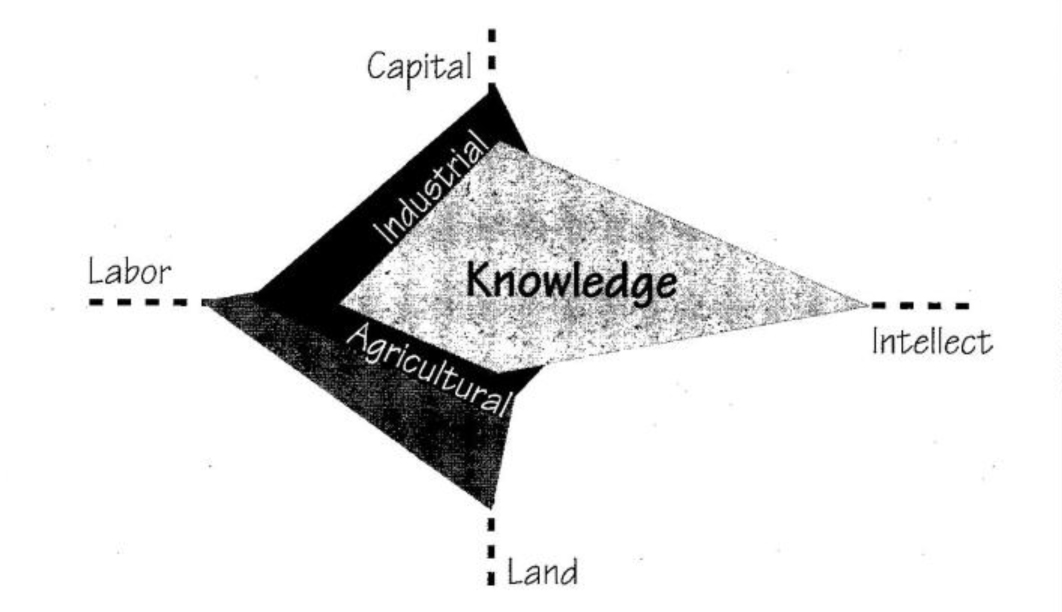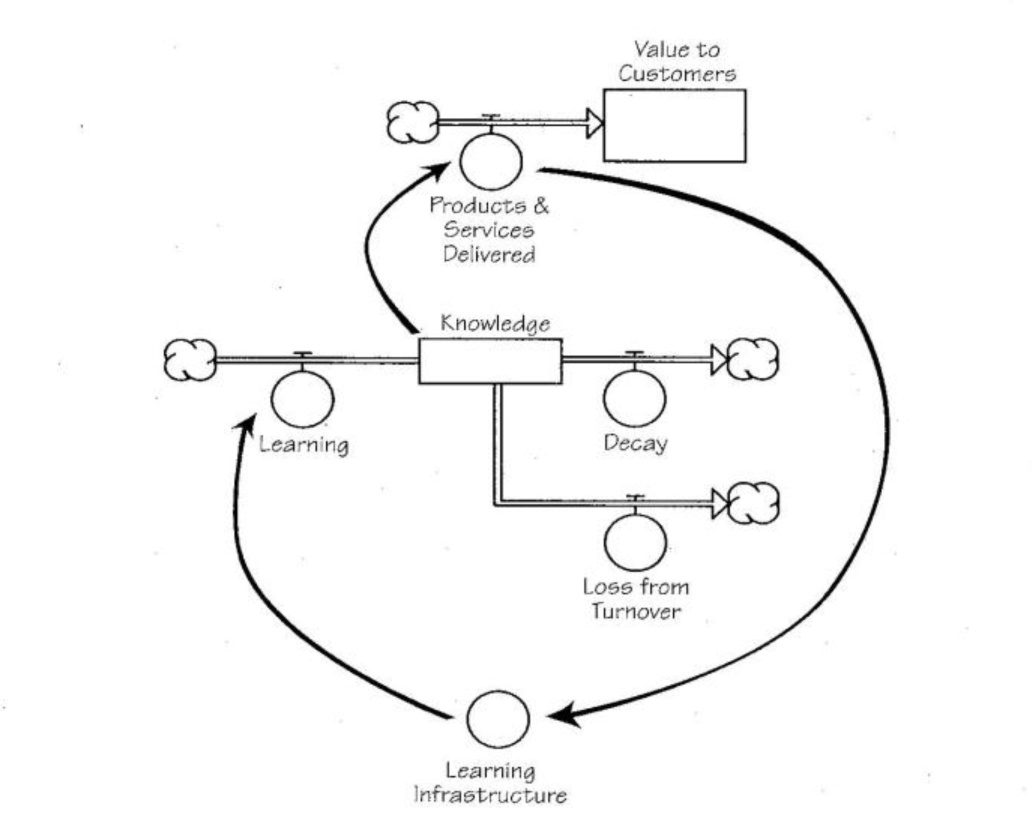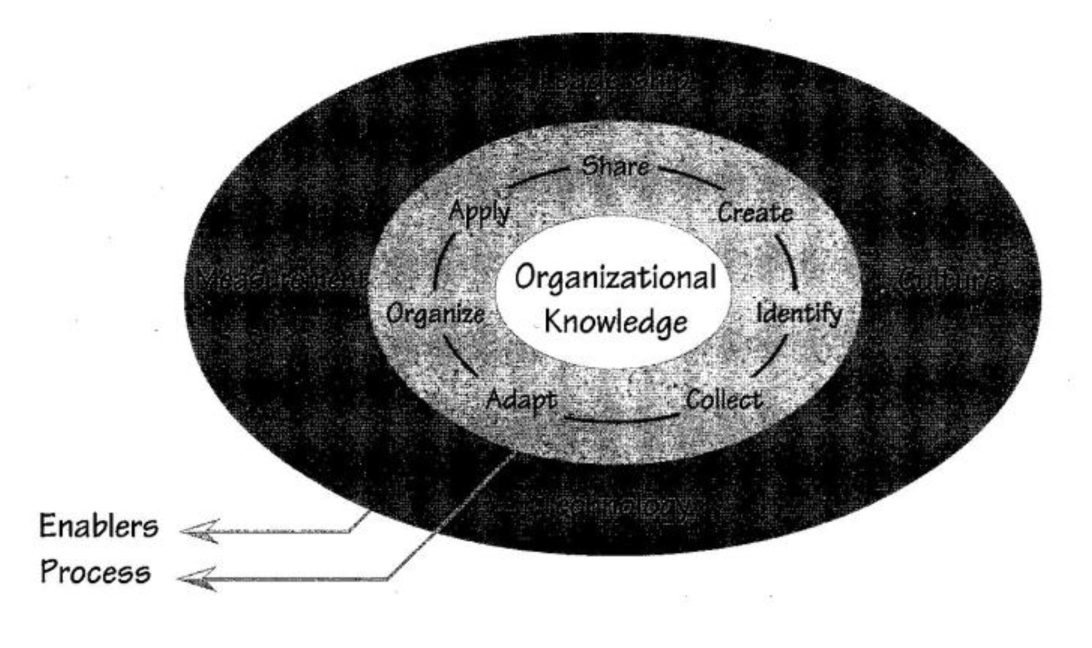The world economy is in the midst of a profound change—one that is creating huge shifts in the way companies are organizing to provide value for customers, owners, employees, and suppliers. According to Charles Savage, author of Fifth Generation Management, the accelerating pace of change signals a revolution in the making—a shift from the Industrial Era to the Knowledge Era.
In the Knowledge Era, products and services will be composed of more intellect and less labor, material, and capital. The primary source of wealth creation will be the human imagination, something that cannot be managed using traditional methods. Thus, organizations will require a different set of operating assumptions for managing and monitoring their operations. Companies that create infrastructures to promote innovation and continual learning will flourish; those that do not respond effectively may find themselves struggling for survival.
Historical Perspective
From a historical perspective, industrialized Western societies have moved through two major eras that set the stage for the Knowledge Era (see “The Shifting Economic Base”). In the Agricultural Era, the main engines of wealth creation were land and labor. Organizations were primarily concerned with the production, movement, and storage of agricultural products within rural communities. Organizational structures were relatively simple, and land and labor were the key “raw materials.”
The Shifting Economic Base

As we move from the Industrial Era Into the Knowledge Era. The base of production will rely more on intellect and less on labor, land, and capital.
In the Industrial Era, labor continued to be important, but land’s contribution to wealth creation was surpassed by a new source—capital. Capital was required to fund the large purchases of plant and equipment, as well as to invest in research and development. Hierarchical structures, financial markets, production techniques (such as mass production), and scientific management philosophies were created to maximize the return on invested capital.
In what Savage calls the Knowledge Era, the traditional engines of wealth creation will be eclipsed by the importance of intellect. The sheer force of knowledge and knowledge creation in all its forms—know-how, know-who, know-what, know-why, know-where, and know-when—will dominate all other means for creating wealth. The shifts in managing for knowledge creation will be as profound as those experienced in the Industrial Era. In fact, the term “managing” may not even apply as companies experiment with new approaches for unleashing the potential and creative capability of all members of organization.
While the full impact of the Knowledge Era has yet to be seen, the shift has already begun. Consider these recent illustrations of how knowledge is becoming a basis for creating competitive advantage:
- Ryder Systems is considering selling its core business of truck leasing to concentrate on its knowledge-based logistics services.
- Software accounts for one-third of the total cost in a Minolta camera. This knowledge-based component makes the product easier to use and more valuable to the consumer.
- Microsoft has declared that its factories are “the human imagination.” Its stock sells at significantly over book value because of the market perception of its future earnings capability—its ability to innovate.
- IBM’s $3.5 billion purchase of Lotus Development included a substantial premium over book value owing to IBM’s belief in Lotus’ ability to continue to innovate and create exciting technology and groupware solutions.
As we enter the knowledge economy, intellectual components will be integrated into more products and services. This will require businesses to fundamentally rethink their past assumptions about management, and to build infrastructure geared toward capitalizing on the collective knowledge and learning capability of all members of the organization.
Managing the Learning Enterprise
What do we mean by “knowledge”? And how can companies create explicit processes for increasing knowledge and learning throughout the company? We define knowledge as the collective experience of the organization, which consists of the interaction between two primary elements: tacit and explicit knowledge.
Tacit knowledge includes things the organization knows, as well as those things it knows how to do but cannot express and codify. For example, one of the highest paid positions in a Dominos Pizza shop is the dough kneader. Attempts to proceduralize or codify how these “kneaders” perform their job has proved fruitless for Dominos. Therefore, the organization has instead focused on training new workers through apprenticeship programs, as well as retaining experienced “kneader” through higher salaries.
Explicit knowledge consists of the valuable information that can be expressed, communicated verbally, or codified through organizational artifacts such as knowledge repositories, policy manuals, user guides, visioning documents, etc. The process of learning through experience increases tacit knowledge, while codifying these experiences increases explicit knowledge. If we look at knowledge management from a structural perspective, the “learning rate” (of both tacit and explicit knowledge) is the inflow that increases overall organizational knowledge (see “Knowledge: A Structural View”). “Knowledge decay” (in the form of technology obsolescence or innovations that outdate the organization’s work) and “knowledge loss” (in the form of people leaving the organization or moving to other areas in the firm) are outflows that decrease the overall level of knowledge. Maximizing organizational knowledge, therefore, involves designing processes that in-crease the rates of learning and codification, and finding ways to decrease knowledge decay and loss.
But how can organizations design explicit knowledge-management processes? We have identified four specific areas of activity that can aid in this process:
1. Clearly articulate the purpose of creating organizational knowledge and how knowledge fits into the company’s overall business strategy.
2. Develop explicit knowledge and learning strategies that will enable the company to achieve its purpose.
3. Build organizational learning and knowledge-leveraging structures to implement the strategies.
4. Create feedback systems to measure the successes and shortcomings of the efforts, and provide data for continually modifying the strategies.
Together, these four elements make up an overall learning process—one that must be deliberately crafted with the same vigor as any key management strategy. Let’s briefly explore what this process looks like in more detail.
1. Clearly articulate the purpose of creating organizational knowledge.
In his book The Knowledge-Creating Company, Ikujiro Nonaka describes the Japanese view that “a company is not a machine but a living organism, and much like an individual, it can have a collective sense of identity and fundamental purpose. This is the organizational equivalent of self-knowledge—a shared understanding of what the company stands for, where it is going, and what world it wants to live in, and, most importantly, how it intends to make the world a reality.”
Without a clear understanding of how creating structures to improve learning and knowledge creation will provide value to customers and stake-holders, an organization’s efforts will be diffused and ineffective. A sense of a larger purpose creates the underlying impetus that will drive and sustain the process.
Developing this deep sense of purpose involves continuous conversations within the organization about what we want to achieve. It begins by creating a space in which these conversations can take place, which can continue throughout the next steps of the process. This awareness of the organization’s larger purpose, coupled with a clear understanding of current reality, provides the overall context for organizational learning.
2. Develop explicit knowledge and learning strategies.
Exploring the larger purpose of learning activities explains why an organization should develop a learning orientation; creating learning strategies focuses on how the organization will achieve its learning objectives. A company’s unique learning strategy will depend on the organization’s purpose and overall business strategy. A company that is committed to being “first to market” in order to generate high-margin sales from early adopters will have a dramatically different knowledge strategy than an organization that thrives on producing low-cost, mass-produced imitations.
Several frameworks exist for helping companies develop knowledge strategies. One such framework is the Organizational Learning Inventory (OLI), developed by Edwin Nevis, Anthony DiBella, and Janet Gould, who are affiliated with the MIT Center for Organizational Learning. The OLI was created through detailed studies of several companies in the U.S., Europe, and Asia to identify specific actions that promote organizational learning.
Knowledge: A Structural View
 From a structural perspective, maximizing organizational knowledge Involves designing processes that Increase the learning rate, and finding ways to decrease knowledge decay and loss.
From a structural perspective, maximizing organizational knowledge Involves designing processes that Increase the learning rate, and finding ways to decrease knowledge decay and loss.
The cornerstone of the OLI is a set of 10 Facilitating Factors and seven Learning Orientations. Facilitating Factors are those activities or attitudes (such as environmental scanning and an experimental mindset) that promote or inhibit learning, while Learning Orientations describe stylistic differences in the ways companies approach learning (such as focusing on breakthrough thinking versus incremental improvements). By using the OLI to identify their overall learning system, companies can develop ways to manage their learning processes more explicitly.
Another framework is the Knowledge Management Assessment Tool (KMAT), created by Arthur Andersen and the American Productivity Quality Center. The KMAT was developed with input from 21 companies and has been used by more than 100 additional companies. It is used to help managers identify knowledge-management areas in their organization that require greater attention, as well as those knowledge-management practices in which the company excels (see “The KMAT Method”).
The KMAT Method

The learning cycle of create, identify, collect, adapt, organize, apply, share is the process that organizations use to access and utilize information In their organizational systems. This is the information engine that creates organizational knowledge. The four organizational enablers (leadership, culture, technology, and measurement) facilitate the management of that knowledge:
Leadership encompasses broad issues of strategy—how the organization defines its business and uses Its knowledge assets to reinforce its core competencies, for top-down organizations, “leadership” may be interchangeable with “management.” In more decentralized companies, organizational learning leadership may be found throughout the organization.
Culture reflects how the organization views and facilitates both learning and innovation, Including how It encourages employees to build the organizational knowledge base In ways that enhance customer value.
Technology focuses on how the organization equips its members to communicate with one another, as well as on the systems it uses to collect, store, and disseminate information.
Measurement includes not only how the organization quantifies its knowledge capital, but also how resources are allocated to fuel Its growth.
While both the KMAT and OLI can facilitate the process of designing a learning strategy, they approach it in different ways. The KMAT was originally developed as an external benchmarking tool. It allows participants to rate their performance on 24 emerging knowledge-management practices, as well as determine the importance of these practices to their organization. The OLI, on the other hand, looks at internal capabilities. It is designed to assess an organizational unit as a learning system—identifying the unique strengths and learning style of the work unit, and developing an organizational learning plan that capitalizes on those abilities. The OLI looks at the cultural side of organizational learning, and can be used very effectively as a framework for change management.
Both the OLI and the KMAT provide a structured process for clarifying an organization’s learning strategy, which will ultimately evolve beyond the confines of the tools themselves.
3. Build organizational learning and knowledge-leveraging structures.
Once the company has articulated its knowledge strategy, it can create action plans to close the gaps between the organization’s knowledge vision and its current performance. These action steps often involve building structures to promote effective knowledge creation and application.
For example, a successful oil and gas company was developing a new strategy to drive its future growth efforts, and the management team wanted to understand the systemic relationships between the different parts of the plan. One of the primary elements of the strategy was a shift in focus from growing through acquisitions to investing in exploration and production. However, they also believed that they needed to be the low-cost producer, and that they could only achieve this if they significantly reduced general and administrative expenses.
When they used causal loop diagrams to map the interrelationships among various elements of their strategy, they found that these two objectives were in conflict. In order to expand their exploration and production activities, they would have to increase the number of geologists and related staff to perform the increased work volume. But these salaries were considered part of general and administrative costs, and the pressure to become a low-cost producer would probably necessitate minimizing staff headcounts.
This conflict was resolved when the management team examined industry benchmarking data and found that they already had the lowest general and administrative costs in their peer group. Their margin was large enough that they could increase the staff headcount and still have excellent cost performance. The causal loop diagrams were then used to develop a simulation model that the management team used throughout the organization to create a greater understanding of how the shift in strategy would support the company’s long-term objectives.
Another client created a deliberate communication structure to provide a framework for validating and modifying key assumptions about the business. A cell structure was created for this 700-person organization, consisting of 50 cells of 10-20 employees each. Members of each cell came together in a series of workshops designed to allow them to share their insights about the organization and to learn from one another. The OLI was used to focus the process and engage employees in a meaningful conversation about the company’s particular learning style. Through this process, people found ways to capitalize on the firm’s learning strengths, and to leverage these capabilities throughout the organization.
A third company decided to begin its organizational learning strategy by introducing its employees to the basic concepts of organizational learning and leadership. As a symbol of its commitment to organizational learning, the company created a learning center.
The goal of the center’s staff is to expose the entire management team—approximately 2,000 people—to the disciplines of personal mastery, mental models, team learning, systems thinking, and shared vision. The concepts out-lined in The Fifth Discipline are providing the basic framework for this work. By raising the awareness of the theory and tools of organizational learning through-out the company, management hopes to leverage its core competencies into knowledge-based products and services that are valued by customers.
4. Create feedback systems to monitor progress.
Ongoing feedback on how well the organization is creating and implementing learning structures is critical to the successful implementation of any knowledge strategy. Key questions include:
- Did we get what we expected from building our infrastructure?
- Did we close the gaps identified in our strategy articulation process?
- What new elements do we need to consider in our strategy?
- How are we contributing to our inability to close the gaps identified?
Continual evaluation is crucial for keeping an organization’s learning process relevant in a changing business environment. Action strategies become less useful over time and must be continually revised and adjusted to meet emerging marker challenges.
Moving Forward
As we move into the turbulent and unpredictable Knowledge Era, we will need to engage in new and more meaningful ways in order to become effective at creating the results that we truly desire. Unraveling our old assumptions will take time, patience, and clear direction from every member of the organization. By reexamining our fundamental assumptions about learning and working together, we can begin to create deliberate and thoughtful structures for building upon the knowledge generated at all levels of the organization.
Rian M. Gorey and David R. Dobat are senior managers at Arthur Andersen Business Consulting, and are responsible for the Identification design, and delivery of Arthur Andersen’s Knowledge Services.
Editorial support for this article was provided by Colleen Lannon. Additional contributions were made by Tom Eisenbrook, Sam Israelit, and Lisa Kelley of Arthur Andersen.
Further reading:
Charles Savage, Fifth Generation Management (Boston: Butterworth-Heinemann) 1996.
Ikujro Nonaka and Hirotaka Takeuchi, The Knowledge-Creating Company (New York: Oxford University Press) 1995.
The Coming of the Knowledge-Based Business.” Stan Davis and Jim Botkin, Harvard Business Review, September/October 1994. Notes:
The discussion of tacit and explicit knowledge is based on Nonaka and Takeuchi, The Knowledge-Creating Company.
For more on the Organizational Learning Inventory tool, see “Charting a Corporate Learning Strategy” by Marilyn Darling and Gregory Hennessy (The Systems Thinker, December 1995/January 1996) and “Organizations as Learning Systems” by Janet Gould. Tony DiBella, and Ed Nevis (The Systems Thinker. October 1993).
